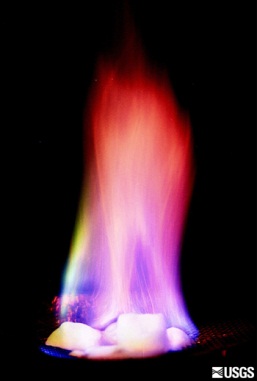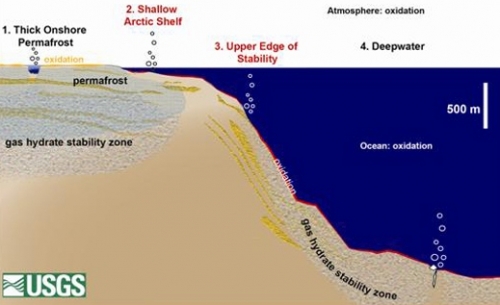Methane – is the sleeping giant awakening?
Methane, the main component of natural gas, is in abundant supply. Yet enormous hidden sources of this potent greenhouse gas are in danger of being released into the atmosphere, accelerating climate change.
 Methane (CH4) seems to be a true blessing: it
serves us well as an energy source in the form of natural gas. And while it’s a
fossil fuel, it is very clean burning — very few pollutants other than carbon
dioxide (CO2) are released, and that amount is small,
compared to the amount released in burning coal. New sources of natural gas right
here in the U.S. have made natural gas comparatively inexpensive. Those new
sources are both land-based, in the form of the controversial hydraulic
fracturing technique (or “fracking,”) and water-based, in the form of conventional
well drilling in the Gulf of Mexico.
Methane (CH4) seems to be a true blessing: it
serves us well as an energy source in the form of natural gas. And while it’s a
fossil fuel, it is very clean burning — very few pollutants other than carbon
dioxide (CO2) are released, and that amount is small,
compared to the amount released in burning coal. New sources of natural gas right
here in the U.S. have made natural gas comparatively inexpensive. Those new
sources are both land-based, in the form of the controversial hydraulic
fracturing technique (or “fracking,”) and water-based, in the form of conventional
well drilling in the Gulf of Mexico.
Yet methane is about twenty times more potent a greenhouse gas (GHG) than is carbon dioxide, though in much lower concentration in our atmosphere. It comes from a variety of sources: organic wastes including human and animal manure, bogs, wetlands and landfills. More recently, it is being released from melting permafrost in the Arctic.
Potentially, from under the seas, there are the methane clathrates or methane hydrates. These are water ice and liquid methane structures formed under high pressure or extreme cold as found in very deep water or Arctic soil. Hydrates concentrate methane to some 160 times its gaseous state. According to the U.S. Geological Survey, the Gulf of Mexico is rich in these methane hydrates and could even serve as a source for future natural gas. Some estimates suggest there are tens of thousands of trillion cubic feet of natural gas tied up in methane hydrates near continental shelves.
There
is some scientific discussion on how these frozen hydrates might let go of
their methane, but one scenario suggests that warmer surface waters mixing with
deeper ocean strata will melt the ice and release the bound methane. Another is
release of methane from permafrost. 
It turns out that waters of the Arctic Ocean are saturated with methane. Recent pole- to-pole air sampling flights have shown methane levels in the Arctic Ocean air to be slightly higher than normal background levels. It isn’t that much – a half of a percent – but the area involved is some 5,427,000 square miles, so it could add up to significant contributions of greenhouse gas in our atmosphere. Permafrost, so named because the soil under the top layer never really defrosts, is beginning to do just that: defrost, releasing methane from the frozen hydrates.
Many old coal-fired electrical power plants are being scrapped across the United States over the next few years to be replaced by natural gas burners — a clear benefit to our air quality and a net negative for GHG build up. As a heating source, cheaper natural gas also means a welcome relief for many family budgets. That’s the good news.
The other side of the methane coin may be a danger that global warming would release more methane from permafrost and deep ocean sources and eventually trigger a feedback loop leading to more rapid atmospheric and ocean warming, leading to more methane release, and so on.
Perhaps how we learn to control our contribution to global warming will help determine the contribution of this powerful resource toward benefit rather than danger.



 Print
Print Email
Email

